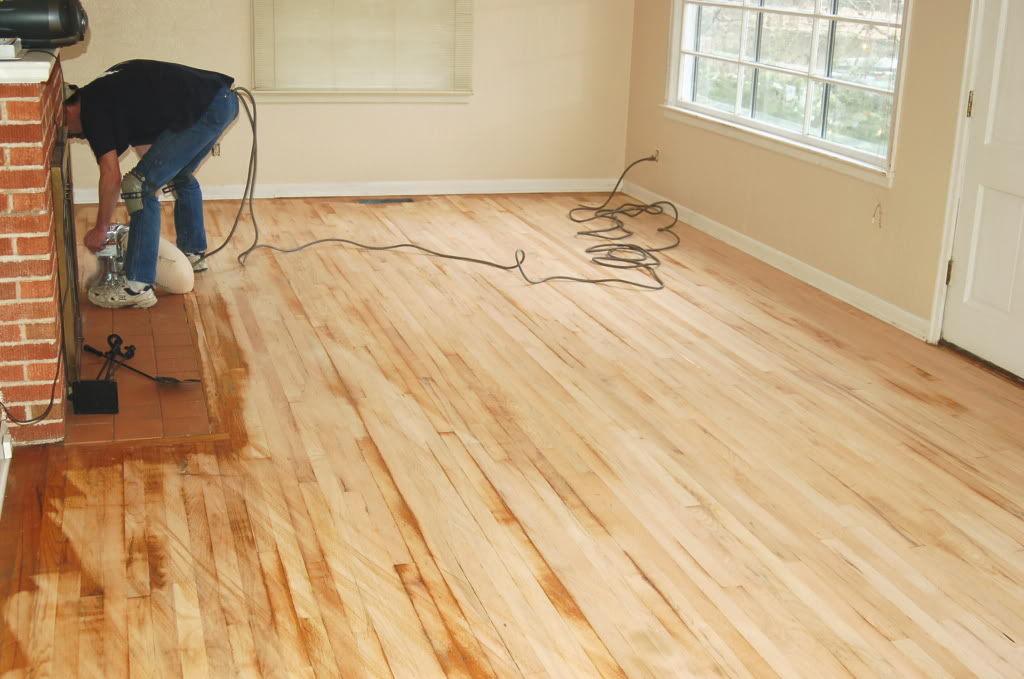Imagine this: you’re staring at your tired, worn-out hardwood floors, dreaming of a fresh, revitalized look. But replacing them feels like a monumental task, a massive undertaking that could upend your entire home. Could there be a shortcut? A way to achieve that dream without the demolition and dust? The answer, my friends, might lie in a technique called “overlaying.” But before you grab your tools and get to work, let’s explore this topic thoroughly, uncovering the realities behind this seemingly simple solution.

Image: shouldirefinishmywoodfloors.blogspot.com
Overlaying wood flooring, essentially adding a new layer of wood on top of existing flooring, can be a tempting cost-effective alternative to ripping up the old. But like any renovation project, there are pros and cons to consider, and knowing the details ensures a successful outcome. This article dives deep into the world of overlapping wood flooring, providing you with the knowledge to make an informed decision, whether you’re a DIY enthusiast or planning a professional renovation.
Understanding the Foundation: When Overlay is Possible
The first step in determining if overlaying is right for you is assessing the condition of your existing floor. It’s like building a house – a solid foundation is crucial for a sturdy structure. Here’s what you need to consider:
- Level of the Subfloor: The surface of your old subfloor needs to be level and smooth. Even slight imperfections can translate into an uneven new floor, leading to squeaks, wobbles, and a less-than-ideal aesthetic.
- Floor Joist Support: Your subfloor must have adequate joist support. If the subfloor is too flexible or the joists are too spaced out, the weight of the new floor could lead to sagging, ultimately jeopardizing the entire structure. Consult with a professional for an inspection if you have concerns.
- Material Compatibility: The surface of the old floor should be compatible with the new flooring material. This typically involves adhering to the manufacturer’s installation instructions. For instance, some engineered hardwood flooring requires a smooth, flat surface, while others can be installed over a more forgiving surface.
Weighing the Pros and Cons: A Balanced Perspective
Once you’ve established the condition of your existing floor, it’s time to evaluate the inherent advantages and disadvantages of overlaying.
Pros
- Cost Savings: Overlaying often translates into significant cost savings compared to full replacement. You’re essentially saving on the cost of removing the old flooring, which is a major expense in any renovation.
- Time Efficiency: Overlaying takes less time compared to a full replacement, meaning less disruption to your life and potentially a quicker turnaround time on your project.
- Retaining Historical Charm: If you’re working with an old house with beautiful original hardwood floors, overlaying allows you to preserve the history and character of your home while still achieving the desired aesthetic.

Image: makezine.com
Cons
- Increased Thickness: Overlay makes your floor thicker, which could affect doorways, molding, and other features of your home. This might require adjustments or even professional assistance.
- Potential for Unevenness: If the subfloor is not perfectly level, the new flooring may feel uneven, leading to an uncomfortable walking experience and potentially affecting the stability of the new floor.
- Limited Design Options: While overlaying offers flexibility, it can limit your design choices. You may not have as many options with overlays as you would with a full replacement, especially with thicker flooring materials.
Choosing Your Overlay Option: Making Informed Choices
Once you’ve decided that overlaying is the right choice, you need to decide on the type of flooring you’ll install. Each option brings its own set of advantages and considerations:
1. Engineered Hardwood
- Pros: Engineered hardwood is more stable than solid wood, making it a popular choice for overlaying. It’s also relatively easy to install, making it a good DIY option for those with average carpentry skills.
- Cons: While engineered wood offers a beautiful hardwood look, it can sometimes be less durable than solid hardwood, especially in high-traffic areas.
2. Thin Flooring Options
- Pros: These include options like luxury vinyl plank (LVP), laminate flooring, and thinner engineered wood. The thin profile of these options makes them ideal for overlaying, minimizing the impact on the overall height of your floor.
- Cons: Thin flooring options often lack the same level of durability as thicker hardwoods and may require specialized subfloor preparation for a seamless installation.
3. Underlayment Considerations
- Importance: Choosing the right underlayment is crucial for a successful overlay, providing cushioning and soundproofing, while also promoting the stability and longevity of your new floor.
- Types: You’ll find various underlayment options like foam, rubber, and cork, each offering different levels of cushioning, sound absorption, and moisture resistance. Research and select the best underlayment for your specific flooring and application.
Can You Put New Wood Flooring Over Old Wood Flooring
Expert Insights for a Successful Overlay
Overlaying is not a one-size-fits-all solution. It’s essential to get professional advice from a qualified flooring contractor or a trusted home improvement expert. They can provide personalized guidance based on your specific situation, assessing the condition of your existing floor, recommending the right materials, and ensuring a flawless installation.
Remember, overlaying is a significant renovation undertaking. Proper planning, careful research, and expert consultation are essential for a successful project that brings the beauty and functionality you desire to your home.






